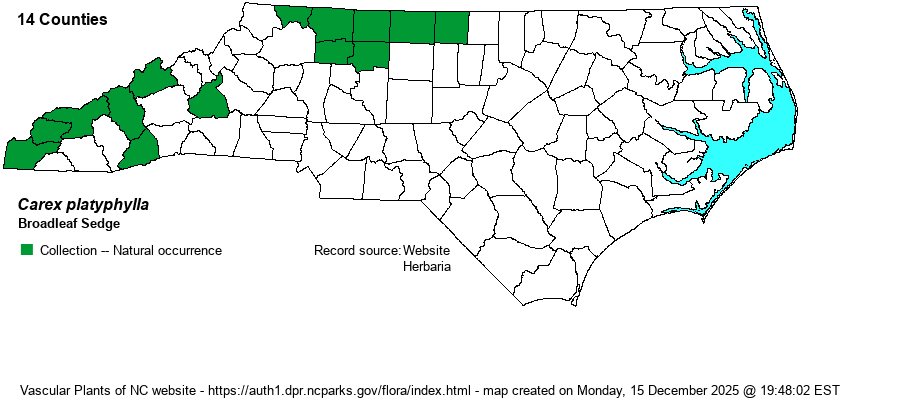| Author | Carey | |
| Distribution | Mountains and northern Piedmont. The gap in the northern Mountains is probably not real, and is likely to be narrowed with additional collecting.
ME to southern Que. and WI, south to northwestern SC, TN, and MO. The SC record was uncovered in 2018 in a search of Carex specimens at CLEMS. | |
| Abundance | Uncommon, to perhaps locally frequent. Lack of records for most northern Mountain counties is puzzling. | |
| Habitat | Cove forests, rich mesic conifer-hardwood forests. Sometimes occurs with C. plantaginea, which has a similar NC range. |
| Phenology | Flowering and fruiting mid April-June. | |
| Identification | Broadleaf Sedge is most similar to C. careyana and C. plantaginea, but the plant bases are tan or brownish (vs. red-purple in the others). Some leaves may be as broad as those of C. plantaginea, but the surfaces are smooth or flat, not puckered. | |
| Taxonomic Comments | None
The genus Carex is the largest in North America, and among the largest in the world. In temperate and boreal regions, Carex is often the dominant or co-dominant ground layer in many habitats. Seeds (achenes) are valuable food for birds and small mammals, while foliage is used by birds and mammals to make nests and as food by mammals. Species of Carex often look vastly different from one another -- spikes erect vs. drooping, tiny inflorescence vs. whopping, culms leafy vs. naked, perigynia beaked vs. beakless, stems densely bunched vs. single, etc. The genus has been divided into many sections (or groups), based on shared characters; some taxonomists have suggested that these be different genera, but that proves unworkable (so far). All Carex share the feature of a perigynium (an outer covering) which completely surrounds the achene (seed). This covering may fit tightly or loosely (like a small bladder), depending on which group or species. Details of perigynia shape, ornamentation, presence and size of beak, number of striations (or veins) are all important ID features. In recent years Rob Naczi and colleagues have stressed the importance of arrangement of perigynia -- whether spiral (3+ ranks) or distichous (2-ranked) -- and have named a number of new species as well as split off some older synonyms. Therefore, RAB's (1968) key, excellent for its time, can only be used in a general way today. Members of some sections of Carex are difficult to key out (notably Ovales, Laxiflorae, Griseae); this is in part due to variation among individuals of a species, or failings of the key. FNA has drawings of most species and some species may be found in two or more places within a key, to acount for variability. New species to NC, and new to science(!), continue to be found in NC. | |
| Other Common Name(s) | Broadleaf Silver Sedge, Silver Sedge | |
| State Rank | S2S3 [S3] | |
| Global Rank | G5 | |
| State Status | | |
| US Status | | |
| USACE-agcp | | |
| USACE-emp | | |

